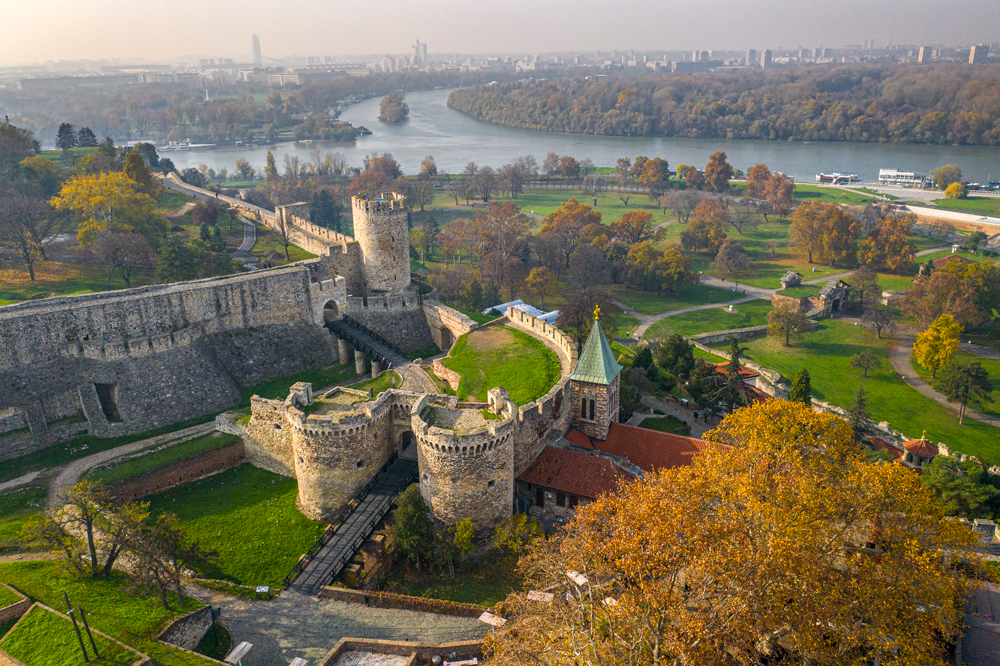At the crossroads where the Balkans meet Central Europe lies one of Europe’s oldest cities, the capital of Serbia, Belgrade.
Although very much a western city, Belgrade’s location and history of inhabitation by many different cultures and civilizations have left it with a feeling of the magic of the east. Belgrade has become one of Southeastern Europe’s favorite city break destinations, much of this due to its rich and vibrant culture, varied nightlife with numerous cafés, restaurants and clubs to choose from, and its young, energetic population.

Even though it was a short two days stay in Belgrade, I felt like there was an alluding charm to this city that I would need to come back again to explore. I had wanted to add Kosovo on my Balkan trip as well, but I read online that Serbia does not recognise Kosovo as an independent country, so I would have complications if I were to re-enter Serbia through Kosovo. I decided to leave Kosovo for another trip.

I took an overnight train from Skopje to Belgrade, crossing the border in the middle of the night. It was around midnight and I was groggy-eyed because I had just been awoken from my sleep. Immigration officers came up on the train to process the exit stamp at the Macedonian side (Tabanovce near Kumanovo), then we moved on to the Serbian border where officials collected my passport for further examination. It is probably one of the rare times that they have seen a Singapore passport. They asked me where I was heading and after checking through their system, returned 15 minutes later with a Serbian entry stamp in my passport.

If you fancy escaping the hustle and bustle of the city for some rest and relaxation then add Ada Ciganlija to your list of places to visit. Once an island on the River Sava, it was turned into a peninsula in the 1960s. With an 8 kilometer long beach lined with cafés and restaurants, it’s a popular spot for locals and tourists alike, and worth visiting all year round.
Zemun, a charming neighborhood in Belgrade, Serbia, offers a blend of rich history, cultural landmarks, and scenic landscapes. Enjoy a leisurely walk along the Danube River promenade, lined with cafes, restaurants, and lush greenery. It’s a perfect spot to relax and savor local cuisine while watching boats drift by.
Another place to check out is Nikola Tesla Museum, named after ‘the man who invented the twentieth century’, it is most famous for its unique collection of Tesla’s original inheritance. The museum’s science and culture exhibits are not only unique in Serbia, but also around the world. It’s an absolute must see for visitors to Belgrade.
The main meeting point in the city must be Trg republike (Republic Square), where the National Museum and the National Theatre are located. It is centrally located in the city, so it is easy to walk to other landmarks around the area and this is also the starting point of the free walking tours. The famous statue of Prince Mihailo on horseback, which is locate on the square, is a popular meeting point for locals. From the square you can reach Knez Mihailova which leads to Belgrade Fortress and Kalemegdan Park. The street is popular for its interesting architecture and being pedestrianized it is pleasant to stroll along.
For a slice of history, do visit Kalemegdan and Belgrade Fortress. Located within Kalemegdan Park, Belgrade Fortress was originally built by the Romans, but has since been renovated by both the Byzantines and the Ottomans. The area surrounding the fortress was turned into a public park in the 1980s. Locals and tourists alike come to the park to enjoy a relaxing stroll or to admire the military structures on display. The park also houses Belgrade Zoo, the Military Museum, Cvijeta Zuzorić Art Pavilion, and a small amusement park. This is also the area where Belgrade’s rich past as a bridge between East and West is the most evident. The rock overlooking the meeting point of the River Danube and the River Sava, known as the Nucleus of the City, first became a settled area thousands of years ago, and offers unrivaled views of the meeting of the rivers.

Sveti Sava, this enormous Eastern Orthodox temple, is one of the largest in the world. It vies with Barcelona’s Sagrada Familia for the dubious distinction of being famously unfinished for far too many decades. It’s been under construction since the 1930s, with interruptions brought about by wars and other shattering events. But while the interior’s frescoes are still being painted, a visit down to the crypt offers a glimpse of what’s still to come. Its vaulted ceilings are glittering with gilt and beautifully painted frescoes.

In terms of cuisine, traditional Serbian cuisine is heavily based on meat, and has strong Turkish likeness to Turkish cuisine with Hungarian and Austrian influences. Serbians enjoy a glass of local wine or fruit juice with their meals, and šljivovica, Serbian plum brandy, is a very popular drink. For an authentic meal and an enjoyable afternoon or evening head to the bohemian quarter, Skadarlija. The areas is often compared to Montmartre in Paris, and has a relaxed and vibrant atmosphere. Alongside your ćevapčići, kebab style meat, traditional side dishes of beans, peppers and cabbage are usually offered. Traditional starters such as proja, kajmak, and dried meat are popular, and for desert you can choose from traditional dishes like Serbian style baklava, or krempita and apple pie which are desserts of Austro-Hungarian influence. If all the meat gets a little too much for you, there are plenty of restaurants serving international cuisine to choose from.

So if you sick of the usual London, Paris or Rome, do head further east where prices become more affordable and Belgrade is waiting to surprise you!














